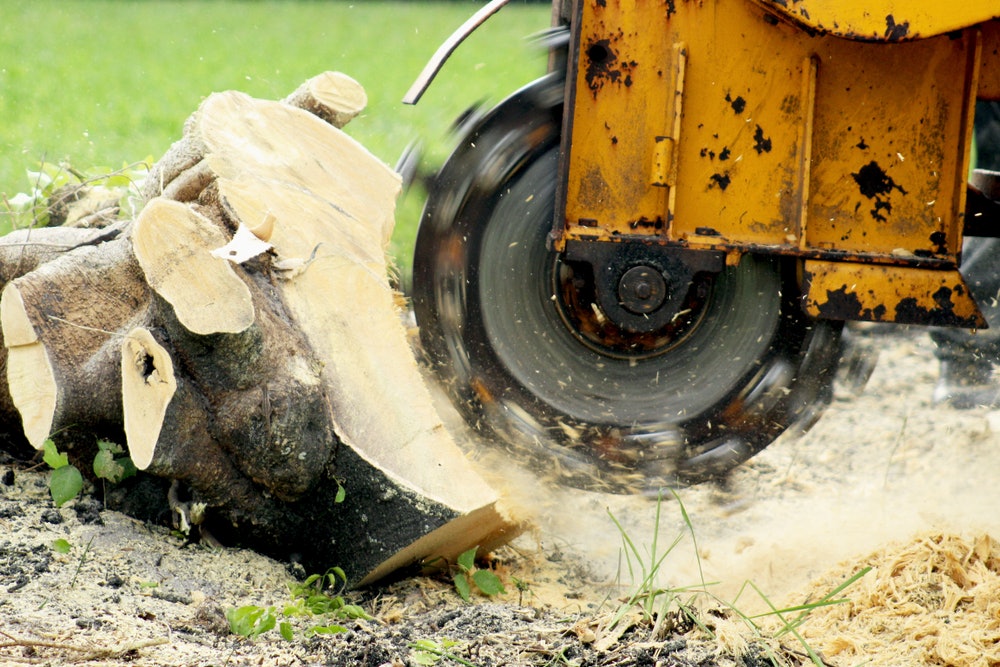Can I grind a stump myself? Yes, you can grind a stump yourself using a stump grinder. However, it’s essential to understand the stump removal process, operating a stump grinder safely, and following proper stump grinding techniques before you begin. This guide will walk you through every step, from preparing for stump grinding to stump grinder maintenance and even stump grinder rental tips, ensuring a successful and safe project.

Image Source: img.totallandscapecare.com
The Basics of Stump Grinding
A stump grinder is a powerful machine used to remove tree stumps by grinding them into small chips. This process is more effective and less labor-intensive than digging out a stump. It’s crucial to understand how these machines work and the risks involved before using one.
Different Types of Stump Grinders
There are several types of stump grinders, each suited for different needs and applications:
- Walk-Behind Stump Grinders: These are the most common type for homeowners and rental companies. They are relatively easy to operate and maneuver.
- Tow-Behind Stump Grinders: These are larger and more powerful than walk-behind models. They are towed behind a vehicle and are suitable for larger stumps or commercial use.
- Self-Propelled Stump Grinders: Similar to walk-behind models but with powered wheels, making them easier to move on uneven terrain.
- Hydraulic Stump Grinders: These are typically mounted on skid steers or excavators and are the most powerful and efficient for large-scale stump removal.
Choosing the Right Stump Grinder
Selecting the right stump grinder depends on the size and number of stumps you need to remove. Consider these factors:
- Stump Size: Larger stumps require more powerful grinders.
- Terrain: Uneven or sloped ground may require a self-propelled or tow-behind model.
- Experience Level: If you’re a beginner, a walk-behind model is easiest to learn.
- Budget: Rental costs vary depending on the size and type of grinder.
Table: Stump Grinder Types and Applications
| Type | Size of Stumps | Terrain | Experience Level | Best Use |
|---|---|---|---|---|
| Walk-Behind | Small to Medium | Relatively Flat | Beginner | Homeowners, Small Jobs |
| Tow-Behind | Large | Variable | Intermediate | Larger Stumps, Commercial Use |
| Self-Propelled | Medium to Large | Uneven | Intermediate | Difficult Terrain |
| Hydraulic (Skid Steer) | Very Large | Variable | Experienced | Large-Scale Stump Removal, Commercial Projects |
Preparing for Stump Grinding
Proper preparation is crucial for a safe and effective stump grinding experience. This includes assessing the site, gathering necessary equipment, and taking safety precautions.
Assessing the Site
Before you start, carefully inspect the area around the stump.
- Clear the Area: Remove rocks, roots, and debris that could be thrown by the grinder.
- Mark Underground Utilities: Call your local utility company to locate and mark any underground lines. This is essential for preventing damage and ensuring your safety.
- Consider Surroundings: Be aware of nearby structures, fences, and landscaping that could be damaged.
Gathering Necessary Equipment
Make sure you have the following equipment:
- Stump Grinder: Choose the appropriate type and size for your project.
- Personal Protective Equipment (PPE): Safety glasses, hearing protection, work gloves, sturdy boots, and long pants are essential.
- Shovel and Rake: For clearing debris and leveling the ground.
- Water Hose: To keep the stump and grinder cool and reduce dust.
- Marking Paint or Flags: To mark the grinding area.
Safety Precautions Before Starting
Safety is paramount when operating a stump grinder.
- Read the Manual: Always read and understand the manufacturer’s instructions before using the grinder.
- Inspect the Grinder: Check for any damage, loose parts, or worn teeth.
- Wear PPE: Always wear appropriate personal protective equipment.
- Keep Bystanders Away: Ensure that no one is within a safe distance (at least 50 feet) of the grinder while it’s in operation.
- Plan an Escape Route: In case of emergency, know where you can quickly move to safety.
Step-by-Step Guide to Stump Grinding
Follow these steps for effective and safe stump grinding:
Step 1: Position the Stump Grinder
- Place the grinder directly in front of the stump, ensuring the cutting wheel is aligned with the highest point of the stump.
- If using a walk-behind grinder, engage the wheel brakes to keep it stable.
Step 2: Start the Engine
- Follow the manufacturer’s instructions for starting the engine.
- Allow the engine to warm up for a few minutes.
Step 3: Begin Grinding
- Slowly lower the cutting wheel onto the stump.
- Move the grinder back and forth across the stump in a sweeping motion.
- Grind in small increments (1-2 inches) to avoid overloading the machine.
- Use the water hose to keep the stump and cutting wheel cool and to reduce dust.
Step 4: Grind Below Ground Level
- Once you’ve ground the stump down to ground level, continue grinding several inches below the surface (typically 4-6 inches). This will allow you to cover the area with soil and plant grass or other vegetation.
- Move the grinder around the perimeter of the stump to grind any large roots near the surface.
Step 5: Clean Up
- Turn off the grinder and allow the cutting wheel to come to a complete stop.
- Use a shovel and rake to remove the wood chips and debris from the hole.
- Fill the hole with soil and tamp it down.
- Consider adding topsoil and seeding the area for grass growth.
Stump Grinding Techniques
- Sweep Method: The most common technique, moving the grinder in a side-to-side arc.
- Plunge Cut Method: For larger stumps, make a series of vertical cuts into the stump, then connect them.
- Root Chasing: Follow the roots outward from the stump to grind them below the surface.
Table: Stump Grinding Techniques
| Technique | Description | Best For | Difficulty |
|---|---|---|---|
| Sweep Method | Moving the grinder back and forth in a sweeping motion. | Most Stumps | Easy |
| Plunge Cut | Making vertical cuts into the stump and connecting them. | Large Stumps | Moderate |
| Root Chasing | Following roots outward from the stump to grind them below the surface. | Removing Surface Roots | Moderate |
Stump Grinder Safety Tips
Safety is critical when using a stump grinder. Here’s how to use a stump grinder safely:
- Always Wear PPE: Protect your eyes, ears, and body.
- Maintain a Safe Distance: Keep bystanders at least 50 feet away.
- Never Operate Under the Influence: Alcohol or drugs can impair your judgment and coordination.
- Be Aware of Kickback: Stump grinders can kick back if the cutting wheel encounters a hard object or gets pinched. Be prepared to react quickly.
- Use Proper Body Positioning: Maintain a firm grip on the grinder and keep your feet firmly planted.
- Take Breaks: Stump grinding can be physically demanding. Take regular breaks to avoid fatigue.
- Never Leave the Grinder Running Unattended: Turn off the engine when you’re not actively grinding.
- Store Properly: Store the grinder in a safe, dry place when not in use.
Specific Safety Concerns
- Flying Debris: Wood chips and rocks can be thrown at high speeds.
- Noise: Stump grinders are very loud and can cause hearing damage.
- Vibration: Prolonged exposure to vibration can cause hand-arm vibration syndrome (HAVS).
- Kickback: The grinder can kick back if the cutting wheel encounters a hard object.
Stump Grinder Maintenance
Regular maintenance will keep your stump grinder running smoothly and safely.
Routine Checks
- Check the Teeth: Inspect the cutting teeth for wear and damage. Replace worn or damaged teeth as needed.
- Check the Belts: Inspect the drive belts for cracks or wear. Replace them if necessary.
- Check the Fluid Levels: Check the engine oil, hydraulic fluid (if applicable), and coolant levels.
- Grease Fittings: Lubricate all grease fittings according to the manufacturer’s instructions.
- Air Filter: Clean or replace the air filter regularly.
Long-Term Maintenance
- Sharpening Teeth: Keep the cutting teeth sharp for efficient grinding.
- Replacing Worn Parts: Replace worn belts, bearings, and other parts as needed.
- Storing the Grinder: Store the grinder in a dry place and protect it from the elements.
Troubleshooting Common Issues
- Engine Won’t Start: Check the fuel level, spark plug, and air filter.
- Grinder Not Cutting Efficiently: Check the teeth for sharpness and replace them if necessary.
- Overheating: Check the coolant level and clean the cooling fins.
Stump Grinder Rental Tips
Renting a stump grinder can be a cost-effective alternative to buying one.
Choosing a Rental Company
- Reputation: Choose a reputable rental company with well-maintained equipment.
- Availability: Make sure the grinder you need is available when you need it.
- Pricing: Compare prices from different rental companies.
- Support: Ask about technical support and maintenance services.
What to Ask Before Renting
- Operating Instructions: Make sure you receive thorough operating instructions.
- Safety Guidelines: Review all safety guidelines and precautions.
- Maintenance Requirements: Ask about any maintenance tasks you’re responsible for.
- Insurance Coverage: Inquire about insurance coverage in case of damage or accidents.
Understanding Rental Agreements
- Read the Fine Print: Carefully read the rental agreement before signing.
- Note Any Existing Damage: Inspect the grinder for any existing damage and document it in the agreement.
- Understand the Return Policy: Know the return date and any associated fees for late returns.
Best Method for Stump Grinding
The best method for stump grinding depends on several factors. For most homeowners, a walk-behind stump grinder using the sweep method is the most practical. For larger, more complex jobs, a tow-behind or hydraulic grinder might be necessary. Always prioritize safety, proper preparation, and regular maintenance to ensure a successful stump removal process. By following these guidelines, you can effectively and safely remove tree stumps and reclaim your yard.
Frequently Asked Questions (FAQ)
- What is the average cost to grind a stump? The cost varies based on stump size, location, and the company you hire. Expect to pay between $100 and $400 per stump.
- How deep should I grind a stump? Grind at least 4-6 inches below ground level to allow for replanting.
- Can I rent a stump grinder? Yes, many rental companies offer stump grinders for rent.
- Who is responsible for locating utilities before stump grinding? It is the operator’s responsibility to call 811 (in the US) to locate and mark underground utilities before starting any digging or grinding.
- What do I do with the stump grindings? Stump grindings can be used as mulch, compost, or fill material.
- Is stump grinding better than stump removal? Stump grinding is often preferred because it’s less disruptive and more cost-effective than complete stump removal.
- How long does it take to grind a stump? The time varies depending on the size and type of stump. A small stump might take 30 minutes, while a large one could take several hours.
- Can I grind a stump in the rain? It is not advisable to grind a stump in heavy rain. The wet conditions can make the job more dangerous and less efficient.

Hi, I’m Larry Fish, the mind behind MyGrinderGuide.com.. With a passion for all things kitchen appliances, I created this blog to share my hands-on experience and expert knowledge. Whether it’s helping you choose the right tools for your culinary adventures or offering tips to make your kitchen more efficient, I’m here to guide you. My goal is to make your time in the kitchen not only easier but also enjoyable! Welcome to my world of kitchen mastery!
